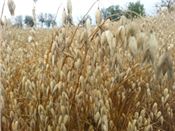|
Kentucky Small Grain Variety Test Results Available – Include Oats Evaluation

BILL BRUENING
LEXINGTON, KY.
In Kentucky there are approximately 1000 acres of oats produced on around 90 farms annually. Of the winter small grain crops grown in Kentucky, oats are the least cold tolerant and most susceptible to winter kill. Most oats produced in the U.S. are spring oats grown in cooler northern states such as Minnesota, Wisconsin, North and South Dakota. Kentucky is at the northern range of the winter oat production area. Winter oats are primarily used for livestock feed as either grain or forage/silage. The standard grain test weight for oats is 32 lbs/bu compared with 60 lbs/bu for wheat. This explains why oat grain yields of 140 bu/Acre are not unusual. The low test weight is partially due to the energy rich “groat” grain being covered by a fibrous hull which volumetrically has a substantially greater portion of air space per bushel.
In Kentucky, oats should be planted between September 15 – October 15 at a rate of 60-90 lbs/acre for grain and 90-120 lbs for forage production. Fungicide seed treatments are an inexpensive and effective method of protecting seeds and seedlings from disease. Insecticide seed treatments will also provide some protection from fall insects, such as aphids which can be an issue with early fall planting in warmer conditions. Management of oats is similar to wheat with the exception of spring N fertilization, where a single application of 70 lbs N is recommended in early March. Excessive N rates can cause lodging and disease issues. Oat grain reaches harvest maturity at approximately the same time as mid-late maturing wheat.
2015 Kentucky Small Grain Variety Performance Test Results are available at http://www.uky.edu/Ag/wheatvarietytest/. The UK program evaluates winter oat varieties for grain, forage and straw yield potential. This data can be useful for growers who are producing oats for regional horse markets where both grain (feed) and straw (bedding) yields can affect production profitability. Additionally characteristics, such as test weight, heading date, plant height, lodging and winter hardiness (which is very important) are evaluated. In 2013-14, the oat variety trial had 0 percent winter survival following a very cold winter; this year the 3 oat tests planted 10-8-14, 10-9-14, & 10-24-14 averaged 100 percent, 94 percent & 26 percent winter survival, respectively (earlier planting and plant growth & establishment are important).
While approximately 95 percent of oats produced are used for livestock production, the proportion used for human consumption is increasing with demand. Health conscious homes are aware of the nutritional value, as well as, the health benefits of eating oats. There has been an increased interest in home garden oat production.
The palatability and quality of oats as forage is reported to be the best of small grains, however because of its lack of cold hardiness – it is not recommended in Kentucky. Wheat also produces high quality forage and typically does not have winter survival issues and can be planted later. Grain producers must also weigh the winter survival risk when contracting for oat grain production. In most years winter kill is not a big issue, particularly if you plant early at the recommended seeding rate and select a high yielding variety with a good winter survival rating. ∆
BILL BRUENING: Research Specialist, University of Kentucky
|
|